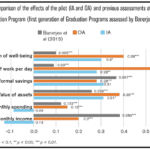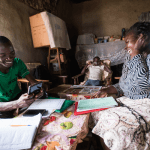Climate-Proofing Poverty Graduation Programs: A New Study Explores Solutions
Imagine building a business from the ground up – then disaster strikes and you must liquidate all your assets just to keep your family alive. Now imagine that scenario repeating itself with every drought and flood cycle, because you live in a place where climate change has exacerbated intense weather events. Faced with challenges like this, the odds of lifting yourself and your family out of extreme poverty become long indeed.
Drought, Poverty and Gender
These challenges are particularly daunting for women and children, who bear a disproportionate share of the burden of extreme poverty and climate change’s cascading effects.
“Women and children are 14 times more likely to die during natural disasters because of their greater vulnerability as a result of factors that include poverty and the social norms of their communities,” write Kristalina Georgieva, CEO of the World Bank, and Ngozi Okonjo-Iweala, chair of the Global Alliance for Vaccines and Immunization, in CNN’s GANTNews. “And after disasters strike, it is also generally much harder for poor women to recover their economic positions than their male counterparts.”
This dynamic is painfully visible in Kenya, where the national government declared a national drought emergency in February. Experts have concluded that the long-term consequences of this drought could be worse than the drought of 2011, which was said at the time to be the region’s worst drought in 60 years. The arid and semi-arid regions in northern Kenya were among the hardest hit, leaving:
- 7 million people severely food insecure;
- 3 million people without access to clean water;
- An estimated 357,285 children and lactating mothers acutely malnourished; and
- Communities unable to reach sustained humanitarian assistance, at risk of emergency levels of hunger and one step away from famine.
The Last Mile of Economic Isolation
Samburu County is a remote and arid rural area just over 200 miles north of Nairobi. About 92 percent of Samburu County’s agricultural land is categorized as low potential, leaving households reliant on livestock. An estimated 75.8 percent of people in Samburu lived in poverty in 2016, which is significantly higher than Kenya’s national poverty rate of 45.2 percent.
There are few roads, and no access to formal financial institutions, healthcare facilities or large employers—it is the true “last mile” of economic and social isolation. Families in arid Samburu are especially vulnerable to the impacts of drought. In March, The Standard reported on a survey that found over 20,000 children under the age of 15 to be suffering from malnutrition and stunted growth.
Samburu is one of the counties where The BOMA Project implements a gender-focused, resilience-building poverty graduation program. BOMA provides women with cash transfers, training and mentorship to start a business and build savings. Poverty graduation programs, which transfer assets and skills, can set women on a path toward higher income and greater empowerment. But how to ensure that those gains are sustainable and not at risk of being eradicated every time a crisis strikes?
An Ambitious RCT
In February, the Feed the Future Innovation Lab for Assets and Market Access at the University of California, Davis – a research center funded by USAID – completed a baseline survey for a five-year randomized controlled trial (RCT) in Samburu in partnership with BOMA. The trial will test whether the combination of a successful graduation program for women in ultra-poverty, together with index-based livestock insurance, can provide a more stable income and durable empowerment in spite of drought and setbacks.
“We know that programs like The BOMA Project empower women, but in areas at a high risk of drought those hard-won gains are vulnerable to collapse,” says Michael Carter, director of the AMA Innovation Lab and a principal investigator on the project. “Insurance could be one way for these women to secure a more lasting empowerment while also helping them to avoid coping strategies that can sacrifice their family’s future wellbeing.”
Women-owned businesses mean more than just higher incomes and greater resources at home: They can also lead women to have a stronger voice in household decisions, allowing them to advocate for themselves and their children.
“Empowering women, giving them the tools to forge a pathway out of extreme poverty, can solve one of the biggest global challenges facing us this century,” says Kathleen Colson, founder and CEO of The BOMA Project. “But those gains cannot be temporary. Achieving sustainable, long-term resilience and self-sufficiency is crucial, and has always been part of our vision.”
Supporting Income and Empowerment Despite Drought
The RCT in Samburu will pair The BOMA Project’s graduation program with index-based livestock insurance (IBLI) from the International Livestock Research Institute (ILRI). Like the businesses these women start, the insurance will also be in their name, with any payouts going directly to them. Keeping these resources under women’s control should help them to maintain both the income they generate and their empowerment in the home.
The IBLI program was established in 2010 by Andrew Mude, an economist at ILRI and co-principal investigator, with Carter, on the BOMA Project RCT. IBLI has had a tangibly positive impact on Kenyan pastoralists in Marsabit, a neighboring county to the east of Samburu. A 2013 study found that insured households were 36 percent less likely than the non-insured to sell their livestock as a way to cope. Insured households were also 25 percent less likely to reduce their meals than non-insured households.
How Insurance Could Support Women’s Empowerment
The RCT measures empowerment in two ways. First, the household surveys focus on women’s participation in household decisions and whether they control their own assets. The survey is adapted from the Women’s Empowerment in Agriculture Index, developed in 2013 by the International Food Policy Research Institute, the Oxford Poverty and Human Development Initiative and USAID.
Second, the research team will measure any change in the kinds of decisions the treated households make. These changes could provide evidence that women are playing a greater role in those decisions, which is an indication of empowerment.
“They might buy more insurance or they might decide to buy camels or goats, which can both stay close to home, instead of cows which need to move to new areas frequently to find grass to eat,” says Andrew Hobbs, a Ph.D. candidate in agricultural and resource economics at UC Davis who spent two weeks in Samburu in February 2018 helping to conduct the study’s baseline survey.
The decision to buy camels or goats instead of cattle is one example of how taking part in household decisions can make a difference in the lives of women and their families. If a household has mainly cattle, the men can end up herding them far away in search of forage for most of the year. In these circumstances, even if men want to help their families, they may have no means to affordably send money. “The women are the ones who see that their kids are hungry or need to have their school fees paid,” says Hobbs.
Changing the System
The first goal of the RCT is to determine whether pairing poverty graduation and index-based livestock insurance will have a more sustainable impact on overcoming extreme poverty and empowering women than either of these two initiatives would have on its own. However, the outcomes could have longer-term implications for policy decisions as governments and other NGOs work to achieve the UN’s Global Goals. Embedding these solutions into social protection networks could decrease the cost of humanitarian crisis response and build long-term resilience and self-sufficiency among the most vulnerable populations. That’s a goal that would benefit the whole world.
Nicole Mills is communications director for The BOMA Project.
Alex Russell is communications director for the Feed the Future Innovation Lab for Assets and Market Access.
Top image: Merille Market in northern Kenya. Photo by David duChemin
Homepage image: United Nations Photo, via Flickr.
- Categories
- Agriculture, Education, Impact Assessment



